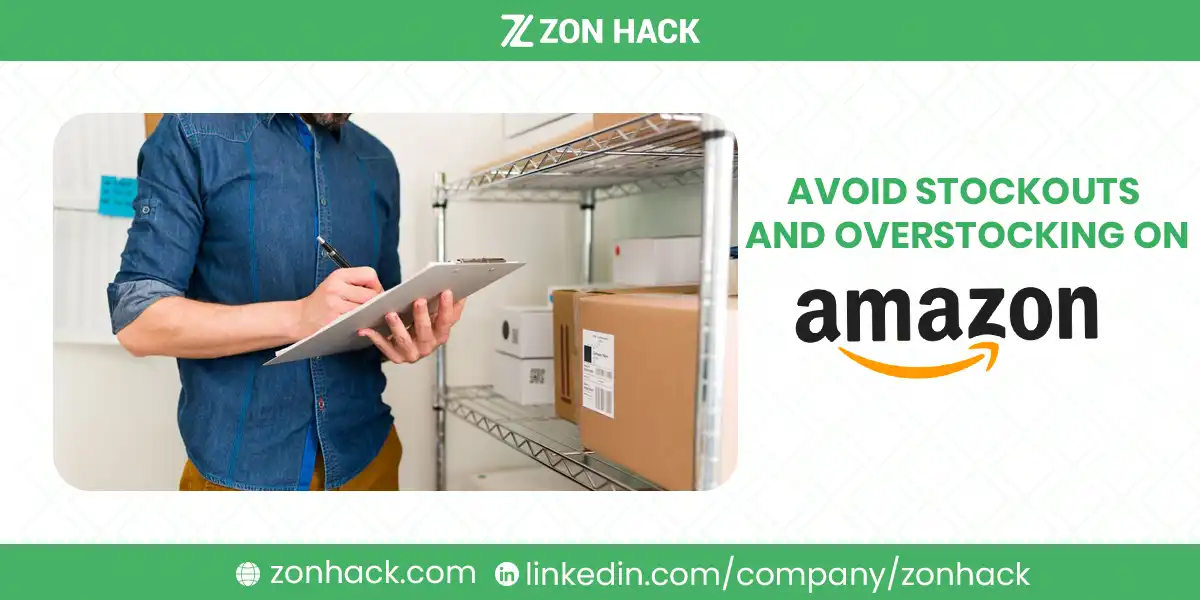Managing inventory effectively is one of the most challenging yet critical aspects of selling on Amazon. Balancing between stockouts and overstocking can mean the difference between sustained profitability and operational inefficiency. Stockouts can lead to lost sales, decreased customer trust, and a drop in your Amazon search rankings. On the other hand, overstocking ties up capital incurs high storage fees, and risks product obsolescence. This article will discuss strategies to prevent both scenarios, ensuring your Amazon business runs smoothly and profitably.
What’s Stockout and Overstocking on Amazon
Effective stock management requires a deep understanding of a few key concepts.
Stockouts occur when you run out of inventory for a particular product, leading to lost sales opportunities and potentially dissatisfied customers. Conversely, overstocking happens when you hold too much inventory, resulting in high storage costs and reduced cash flow. For Amazon sellers, maintaining the right balance is crucial to avoid these pitfalls. Key metrics like the Inventory Performance Index (IPI) and the sell-through rate can help monitor inventory health and optimize your stock levels.
Why Stockouts Happen
Stockouts are more common than many sellers realize and often occur due to a combination of factors:
- Demand Forecasting Errors: Misjudging customer demand is one of the leading causes. For example, failing to account for seasonal spikes, promotional events, or market trends can leave you unprepared.
- Supplier Issues: Even the best suppliers can experience delays, production issues, or logistical challenges that affect your stock availability.
- Unexpected Demand Surges: Viral trends or sudden media attention can cause sales to exceed expectations. For example, a social media post from an influencer promoting your product can create an unexpected sales spike.
- Operational Errors: Poor data management, missed reorder alerts, or a lack of automated systems can lead to stock mismanagement.
What Are the Consequences of Stockouts
The repercussions of running out of stock extend beyond immediate lost revenue. Stockouts directly impact your Amazon seller rankings. Amazon’s algorithm favors consistent availability, and repeated stockouts can harm your product’s visibility. Customers searching for your product may switch to competitors, leading to long-term trust erosion. Additionally, regaining lost rankings often requires increased spending on advertising and promotions, further reducing profitability.
How to Prevent Stockouts on Amazon
Preventing stockouts begins with accurate demand forecasting. Leveraging tools like Helium 10 or Jungle Scout can provide insights into market trends, seasonal shifts, and historical sales data. Here are some proven strategies:
- Set Safety Stock Levels
Maintaining a buffer inventory ensures you can meet unexpected demand or handle delays in restocking. For example, if your average monthly sales are 1,000 units and your supplier lead time is 20 days, you can calculate a safety stock of approximately 667 units (based on daily sales).
- Establish Reorder Points
Use reorder point formulas to determine when to replenish stock. A simple formula is:
Reorder Point = (Daily Sales Velocity × Lead Time) + Safety Stock
- Diversify Suppliers
Relying on a single supplier can be risky. Build relationships with multiple vendors to reduce dependency and mitigate potential delays.
- Leverage Automation Tools
Inventory management systems like SoStocked and Skubana can automate reorder alerts, monitor stock levels, and streamline the restocking process.
By implementing these strategies, you can significantly reduce the likelihood of running out of stock.
Handling Stockouts Effectively
Even with the best planning, stockouts may sometimes occur. When they do, how you handle the situation can make a significant difference:
- Strategic Pricing Adjustments: Gradually increasing prices as stock levels dwindle can help manage demand and extend availability until new stock arrives.
- Pause Advertising Campaigns: Avoid wasting ad spend on unavailable products. Redirect your budget to other in-stock items.
- Expedited Shipping Options: Work with your supplier to expedite production or shipping, even if it incurs additional costs.
- Transparent Communication with Customers: If stockouts occur, provide clear updates on restock timelines. Offering a substitute product or a discount on future purchases can also maintain goodwill.
Why Overstocking Happens
Overstocking, while seemingly less critical than stockouts, can severely impact your business. Common reasons include:
- Overestimating Demand: Sellers may over-order in anticipation of peak seasons or promotional campaigns that don’t perform as expected.
- Inefficient Inventory Practices: Without regular audits, slow-moving products can pile up unnoticed.
- Unanticipated Market Changes: A sudden drop in demand due to economic shifts or changes in consumer preferences can lead to excess stock.
- Poor Product Diversification: Over-investment in a limited product range increases the risk of overstocking slow-moving items.
What Are the Consequences of Overstocking
The financial burden of overstocking can be immense. Amazon’s FBA storage fees are tiered, and long-term storage fees apply to inventory held for more than 365 days. These costs can quickly add up, especially for bulky or slow-moving items. Additionally, excess stock ties up capital that could be used for marketing, launching new products, or operational improvements. There’s also the risk of products becoming obsolete or damaged, further reducing their value.
Consider a seller who overestimated demand for a niche seasonal item. After the season ends, they’re left with hundreds of unsold units incurring monthly storage fees. To move the excess inventory, they’re forced to offer steep discounts, eroding profit margins.
How to Prevent Overstocking on Amazon
Preventing overstocking is just as critical as avoiding stockouts. Sellers can adopt the following strategies to maintain optimal inventory levels:
- Regular Inventory Audits
Schedule periodic audits to identify slow-moving or obsolete stock. This practice allows you to address overstocked items promptly and prevent further accumulation.
- Data-Driven Demand Forecasting
Leverage tools like Forecastly or RestockPro to analyze historical sales data and project future demand accurately. Machine learning algorithms can adjust for market trends and seasonal fluctuations.
- Adopt Just-in-Time (JIT) Practices
By receiving inventory closer to the time it is needed, sellers can reduce storage fees and the risk of excess stock. This approach requires robust coordination with suppliers and efficient logistics.
- Optimize Reorder Quantities
Use the Economic Order Quantity (EOQ) formula to balance order size with holding costs. For example:
• EOQ = √(2DS / H)
Where:
- D: Annual demand in units
- S: Order cost
- H: Holding costs per unit, per year
- Promotional Campaigns for Excess Inventory
Launch time-sensitive sales or bundles to move overstocked items quickly. Offering discounts during off-peak seasons can also help regain cash flow.
Advanced Inventory Management Tools: ZonHack’s Tailored Solutions
Managing Amazon inventory requires precision, insight, and the right tools. This is where ZonHack stands out by offering advanced inventory management solutions tailored to your business needs. With ZonHack, you can optimize every aspect of stock management, ensuring smooth operations and maximizing profitability.
ZonHack’s inventory management tools are designed to handle key challenges, including:
- Accurate Demand Forecasting: ZonHack uses cutting-edge analytics to predict market trends and seasonal demands. By analyzing historical sales data and real-time performance, our tools help you stay ahead of demand fluctuations, reducing the risks of stockouts or overstocking.
- Automated Restocking Alerts: Our system monitors your inventory levels 24/7 and sends automated alerts when stock reaches critical thresholds. Whether it’s setting precise reorder points or maintaining safety stock levels, ZonHack ensures you’re always prepared.
- Supplier Coordination: ZonHack simplifies supplier management by automating purchase orders and tracking shipment schedules for you. This streamlines your supply chain, reducing lead times and minimizing delays.
- Inventory Health Monitoring: With a focus on key Amazon metrics like the Inventory Performance Index (IPI) and sell-through rate, ZonHack helps you maintain a balanced inventory that aligns with Amazon’s guidelines, preventing unnecessary storage fees or penalties.
- Dynamic Pricing Adjustments: Our system can identify products with high stock or low movement and recommend pricing adjustments to encourage sales. Conversely, we suggest price strategies to manage demand during potential stockouts.
- Actionable Insights: ZonHack provides detailed reports that highlight slow-moving products, overstocked items, and upcoming trends. These insights enable you to make data-driven decisions that optimize cash flow and reduce operational waste.
With ZonHack, you’re gaining a partner dedicated to your success on Amazon. Our inventory solutions integrate seamlessly with your existing systems and are backed by a team of experts who provide personalized guidance to optimize your operations.
Key Takeaways
Achieving the perfect balance between stockouts and overstocking requires a proactive and data-driven approach. Accurate forecasting, regular audits, safety stock levels, and efficient use of inventory management tools are essential components. By implementing these best practices, Amazon sellers can improve profitability, enhance customer satisfaction, and maintain a competitive edge in the marketplace.
Remember, inventory management is not a one-time effort. Continuous monitoring and adjustment based on evolving market conditions are critical to long-term success.




